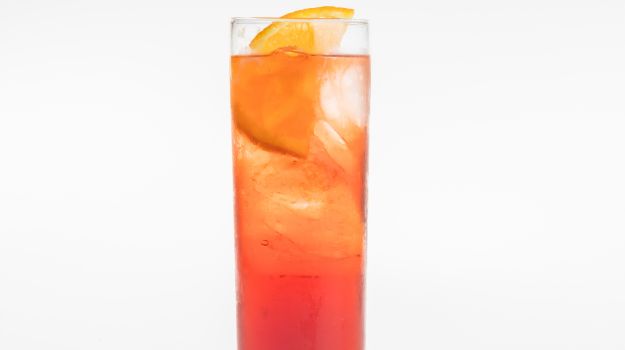PhotoCredit:TheWashingtonPostI'd just settled in at the bar at an upscale Italian restaurant in D.C., the room washed in that late-afternoon light that settles over the world like a layer of gold leaf. I was meeting the hubs for dinner and was headed back to work in the morning, so it was the perfect moment for an Americano.
"No problem," the bartender said. A few minutes later, a cup of coffee was set before me.
I apologized and clarified that I'd been asking for the aperitivo combining Campari, vermouth and soda.
"You asked for an Americano. This is an Americano," he said.
"I'm sorry," I said. "I should've been more specific. It's also a cocktail."
"I've been bartending for 10 years, and I've never heard of it." He whisked the coffee away, his expression equally dark.
Had I really ordered something so obscure? Was I one of those jerks who expect every bartender to know some bespoke cocktail they once had in a tiny Brooklyn bar: "You know, that drink called the No One Ever Orders This? With baijiu and dragonfruit and rhubarb-cardamom bitters?"
To be fair, I'd made assumptions, based on the time of day, the bar's stock of Campari, the fact that the drink has been around since the late 1800s. And it's true that a watered-down espresso is also called an Americano. In fact, according to Marisa Huff, author of "Aperitivo: The Cocktail Culture of Italy," the similarity in names may come from a similarity in process: Like the diluted espresso that American soldiers in Italy favored during World War II, the Americano cocktail is a watered-down version of a drink called a Milano-Torino or Mi-To, itself named for the two origins of its primary ingredient, Campari from Milan, vermouth from Turin.
Still, I like to believe that bartender would be in the minority. Especially in a globe-trotting city like Washington, I'm sure many are acquainted with the Americano and its family of aperitivi: lower-alcohol, appetite-stimulating drinks that, in the context of pre-prandial socialization, may include vermouth, sherry, bitter liqueurs and aromatized wines, pastis, champagne and more. Certain European countries dedicate whole phrases to the activity surrounding aperitifs; "aperitivo," for example, is Italian shorthand not just for the drink but for the hour in which it is drunk and the snacks that accompany it.
The culture varies by country and even by region: You may be drinking spritzes in northern Italy, pastis in France, vermouth in northern Spain, sherry in southern and so forth. In Catalonia, vermouth is often a starter at lunchtime, says Eric Seed, founder of Haus Alpenz, which imports a number of vermouths, quinquinas and other aperitifs. But aperitif - not just the drink, but the activity - "is a very real element of service, and in all three countries," says Seed.
There's such a variety of drinks that can be considered part of the category that it's worth exploring what they have in common. Leith Shenstone, owner of importer Fasel Shenstone, says that what makes an aperitif is some combination of dryness, sweetness, bitterness and sometimes effervescence.
"Bitterness and dryness go hand in hand to activate your saliva glands in the back of your mouth," he says, "and that really whets your appetite, so when you start to drink something that dries out your mouth, you start producing that saliva, and your mouth's going, 'Hmm, I'd really like to eat something salty to go with it, like olives or almonds.' The effervescence, the bubbles open your taste buds a little bit."

Varying degrees of bitterness can be found in vermouths and many other aromatized wines, such as Byrrh, Cocchi Americano and Bonal. Francesco Amodeo, master distiller at local distillery Don Ciccio & Figli, recently expanded into aperitivi with his citrusy Cinque and deep crimson Luna Amara, and says that the various botanicals are chosen specifically to open the stomach and prepare the body to digest food. There are specific botanicals that make a drink "better for the earlier stages of the evening drinking and eating as opposed to the later stage," he notes. The herbs used to flavor aromatized wines (and spirits such as Campari and Aperol) often stem from herbal medicine traditions that go back hundreds of years in his native Italy.
In the United States, the craft cocktail movement has embraced bitter liqueurs and helped rehabilitate the once-bedraggled image of vermouth. And thanks to importers such as Haus Alpenz, Fasel Shenstone and Tempus Fugit (among others), we have access to a variety of quality European aperitifs. Watching the way session (lower-alcohol) beers have exploded in recent years makes me hope that the audience is burgeoning.
But there may still be a leap in terms of attitude and culture. We love our happy hours, and day drinking has become quite the meme - and aperitifs are made for slow summer sipping. Yet I often see #daydrinking social media posts in a context of tongue-in-cheek braggadocio of the "What a naughty girl I am, drinking in broad daylight like a harlot!" variety. They suggest that some of us still feel the local temperance union lurking around the corner, peering at our pleasures through disapproving lorgnettes. None of the great apertifing countries went through Prohibition like we did - and don't get me started on the pros and cons of the Protestant work ethic.
Even activities we would seem to have in common have differences. Take happy hour, for example. Italy's "aperitivo" would seem to correlate, but not so fast. "That sort of sacred sliver of time between work and play . . . is something we haven't ever really done all that well," says Talia Baiocchi, editor in chief of online drink magazine Punch and co-author (with Leslie Pariseau) of "Spritz: Italy's Most Iconic Aperitivo Cocktail, with Recipes."
"For us, happy hour has always been how many drinks can we smash into a really short amount of time for the smallest amount of cash," and traditionally doesn't involve food. In Italy, she says, you don't drink without eating. And where "our values are more about staying at work later and getting up early . . . Italy is just like, their whole goal is to work less."
Still, Baiocchi says she and Pariseau have started to see American drinkers "moving away from this 'How much booze can you fit in the glass' mentality," departing from "the notion that heavy booze is a signifier of seriousness or complexity for something that is more sessionable." Baiocchi and Pariseau explore the breadth of the spritz culture, of which the Aperol Spritz is the most famous (the Rib Tickler is a modern American variation), and conclude that in Italy, the spritz is not just a drink, but an attitude.
I was considering how that attitude might translate stateside when I found out that Elliott Rattley, owner of the Classics restaurant in Silver Spring and a known hater of fussy cocktails, had recently spent a weekend pounding Aperol Spritzes and loved them so much he added them to his menu. At first shocked, I then thought: of course. The spritz is a cocktail in which part of the appeal is looseness, a willingness to toss ingredients together in a rakishly pleasing way. Like many aperitifs, it's perfect for those like Rattley, who like to drink well as part and parcel of socializing, but can't bear the preciousness that can creep into cocktails.
But will Americans discovering classic aperitifs retain the carelessly sophisticated nature of the European tradition? I can only report anecdotally that Rattley's approach to the spritz - involving one friend, one bottle of Aperol, three bottles of prosecco and, late in the evening, falling out of a boat - confirmed my suspicion: If we Americans start traveling down the aperitivi road, we may widen that sucker into a six-lane highway.
(c) 2016, The Washington Post(This story has not been edited by NDTV staff and is auto-generated from a syndicated feed.)







